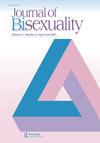双性恋女性抑郁症状高发:性取向和性别对美国全国代表性样本中抑郁症状的影响
IF 1.9
Q2 SOCIAL SCIENCES, INTERDISCIPLINARY
引用次数: 0
摘要
摘要双性恋者抑郁率高于异性恋者,女性抑郁率高于男性;然而,很少有研究量化性取向和性别的共同影响。在2013-2014年和2015-2016年全国健康与营养检查调查中,采用患者健康问卷对抑郁症状进行评估。我们使用汇总和性别分层的泊松回归和稳健方差来确定性取向和性别对抑郁症状的独立影响,并计算由于相互作用而产生的相对过量风险,以检验双性恋取向和女性性别对抑郁症状的共同影响。在调整后的模型中,女性的抑郁症状比男性高1.78倍(99%可信区间[CI]: 1.776, 1.782),双性恋者比异性恋者高1.73倍(99% CI: 1.726, 1.735),双性恋女性比异性恋男性高3.15倍(99% CI: 3.145, 3.163)。我们发现了双性恋女性抑郁症状过度流行的非加性模型的证据。需要针对双性恋妇女独特的心理健康需求提供针对性别的服务。关键词:抑郁症,女同性恋,男同性恋和双性恋健康,相互作用导致的相对过度风险。作者要感谢多伦多大学达拉拉纳公共卫生学院流行病学部门副教授Jennifer Brooks博士对本研究的贡献和对手稿的反馈。免责声明本研究为二次分析,主要数据收集由国家卫生统计中心和疾病控制中心进行。这项研究的结果于2021年10月在美国科罗拉多州丹佛市举行的美国公共卫生协会年会上公布。披露声明作者未报告潜在的利益冲突。数据可用性声明nhanes 2013-2014年和2015-2016年的数据集可在https://wwwn.cdc.gov/nchs/nhanes/Default.aspx.Additional上公开使用,贡献者说明joshun j.s. Dulai joshun Dulai是多伦多大学达拉拉纳公共卫生学院的博士生。他们有十年的研究经验,专注于性少数群体的精神和性健康问题,如抑郁症、自杀、药物使用、性传播和血液传播感染。Rose a . SchmidtRose Schmidt,公共卫生硕士,多伦多大学Dalla Lana公共卫生学院博士候选人。她的混合方法研究侧重于减少危害和创伤知情的围产期药物使用方法。她处理基于性别的健康不平等的阻碍因素,并将社会流行病学方法纳入应用政策研究。本文章由计算机程序翻译,如有差异,请以英文原文为准。
High Prevalence of Depression Symptoms Among Bisexual Women: The Association of Sexual Orientation and Gender on Depression Symptoms in a Nationally Representative U.S. Sample
AbstractBisexual individuals experience higher rates of depression than heterosexual individuals and women experience higher rates of depression than men; however, few studies have quantified the joint effects of sexual orientation and gender. In the 2013–2014 and 2015-2016 National Health and Nutrition Examination Survey, depression symptoms were assessedusing the Patient Health Questionnaire. We used pooled and gender-stratified Poisson regression with robust variances to determine the independent effects of sexual orientation and gender on depression symptoms and calculated relative excess risk due to interaction to examine the joint effects of bisexual orientation and women’s gender on depression symptoms. In adjusted models, depression symptoms were 1.78 times higher in women than in men (99% confidence interval [CI]: 1.776, 1.782), 1.73 times higher in bisexual individuals than in heterosexual individuals (99% CI: 1.726, 1.735), and 3.15 times higher in bisexual women than in heterosexual men (99% CI: 3.145, 3.163). We found evidence for a non-additive model of the excess prevalence of depression symptoms among bisexual women. Gender-specific services addressing the unique mental health needs of bisexual women are needed.Keywords: Depressionlesbian gay and bisexual healthNHANESintersectionalityrelative excess risk due to interaction AcknowledgmentsThe authors would like to thank Dr. Jennifer Brooks, Associate Professor, Epidemiology Division, Dalla Lana School of Public Health, University of Toronto, for her contributions to this study and her feedback on the manuscript.DisclaimerThis study is a secondary analysis, and the primary data collection was conducted by the National Center for Health Statistics, Centers for Disease Control. The results of this study were presented at the American Public Health Association Annual Meeting in October 2021 in Denver, CO, USA.Disclosure statementNo potential conflict of interest was reported by the author(s).Data availability statementNHANES 2013–2014 and 2015–2016 datasets are publicly available to use at https://wwwn.cdc.gov/nchs/nhanes/Default.aspx.Additional informationNotes on contributorsJoshun J. S. DulaiJoshun Dulai is a PhD student at the Dalla Lana School of Public Health, University of Toronto. They have a decade of research experience focusing on mental and sexual health issues in sexual minority populations such as depression, suicide, substance use, and sexually transmitted and blood-borne infections.Rose A. SchmidtRose Schmidt, MPH, is a PhD candidate at the Dalla Lana School of Public Health, University Toronto. Her mixed-methods research focuses on harm reduction and trauma-informed approaches to perinatal substance use. She addresses gender-based determents of health inequity and integrates social epidemiological methodology into applied policy research.
求助全文
通过发布文献求助,成功后即可免费获取论文全文。
去求助
来源期刊

Journal of Bisexuality
SOCIAL SCIENCES, INTERDISCIPLINARY-
CiteScore
2.60
自引率
17.60%
发文量
32
期刊介绍:
The Washington Quarterly (TWQ) is a journal of global affairs that analyzes strategic security challenges, changes, and their public policy implications. TWQ is published out of one of the world"s preeminent international policy institutions, the Center for Strategic and International Studies (CSIS), and addresses topics such as: •The U.S. role in the world •Emerging great powers: Europe, China, Russia, India, and Japan •Regional issues and flashpoints, particularly in the Middle East and Asia •Weapons of mass destruction proliferation and missile defenses •Global perspectives to reduce terrorism
 求助内容:
求助内容: 应助结果提醒方式:
应助结果提醒方式:


